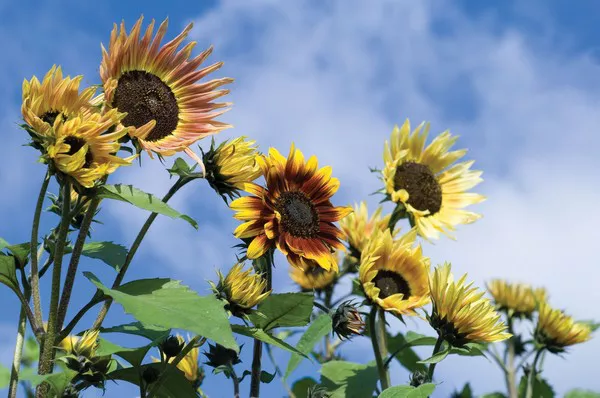Sunflowers, with their vibrant blooms and towering stalks, have long captivated human fascination. Symbolizing resilience, optimism, and vitality, these cheerful flowers stand as a testament to the wonders of nature. However, despite their robust appearance, sunflowers are not immune to wilting—a phenomenon that can leave even the most experienced gardener perplexed. In this article, we delve into the intricate mechanisms that underlie sunflower wilting, exploring the various factors that contribute to this phenomenon and shedding light on strategies to mitigate its effects.
The Anatomy of Sunflower Wilting
At the heart of sunflower wilting lies a complex interplay of physiological processes, environmental factors, and genetic predispositions. To understand why sunflowers wilt, it is essential to first grasp the fundamental anatomy of these plants.
Sunflowers belong to the genus Helianthus and are characterized by their large, daisy-like flower heads and tall, sturdy stems. Central to their structure is the vascular system, comprising xylem and phloem tissues, responsible for the transport of water, nutrients, and sugars throughout the plant. The roots, acting as the primary site of water uptake, absorb moisture from the soil and transport it upwards through the stem to the leaves and petals via the xylem.
Environmental Influences on Sunflower Wilting
One of the primary triggers of sunflower wilting is environmental stress. Sunflowers are native to regions with abundant sunlight and well-drained soil, making them particularly sensitive to fluctuations in temperature, humidity, and moisture levels. Prolonged exposure to high temperatures, coupled with inadequate soil moisture, can lead to water stress—a condition wherein the plant loses water more rapidly than it can absorb it.
Furthermore, excessive wind or prolonged periods of drought can exacerbate water loss through transpiration, the process by which water evaporates from the plant’s leaves. In such circumstances, sunflowers may wilt as a protective mechanism to conserve water and prevent desiccation. Additionally, soil salinity, nutrient deficiencies, and pH imbalance can disrupt the plant’s ability to uptake water and nutrients, further predisposing it to wilting.
Physiological Responses to Wilting
When confronted with water stress, sunflowers enact a series of physiological responses aimed at preserving hydration and ensuring survival. One such response is stomatal closure, wherein the tiny pores or stomata on the leaf surface shut to reduce water loss through transpiration. While this adaptive mechanism helps conserve water, it also limits the intake of carbon dioxide essential for photosynthesis, potentially hindering plant growth and development.
Simultaneously, sunflowers may undergo hormonal changes, including increased production of abscisic acid (ABA), a plant hormone involved in stress responses. ABA promotes stomatal closure and triggers other physiological adjustments, such as the synthesis of osmoprotectants—molecules that help maintain cellular turgor pressure and prevent dehydration.
Genetic Factors and Varietal Susceptibility
Beyond environmental conditions, genetic factors play a pivotal role in determining a sunflower’s susceptibility to wilting. Plant breeders have long sought to develop cultivars with enhanced resilience to stress, selecting for traits such as drought tolerance, disease resistance, and efficient water-use efficiency.
Nevertheless, certain sunflower varieties may inherently exhibit greater vulnerability to wilting due to genetic predispositions or breeding histories. Hybridization and genetic modification techniques offer avenues for introducing desirable traits into sunflower populations, but they also carry inherent risks of unintended consequences, including altered stress responses and physiological imbalances.
Mitigating Sunflower Wilting: Strategies for Success
While sunflower wilting may seem inevitable in the face of adverse conditions, proactive measures can help mitigate its impact and promote plant health and vitality. Implementing the following strategies can bolster sunflower resilience and minimize the risk of wilting:
1. Optimize Irrigation Practices: Ensure adequate soil moisture by implementing a regular watering schedule and utilizing drip irrigation or soaker hoses to deliver water directly to the root zone.
2. Monitor Environmental Conditions: Stay vigilant of temperature fluctuations, humidity levels, and soil moisture content, adjusting cultural practices accordingly to mitigate stressors.
3. Select Resilient Varieties: Choose sunflower cultivars bred for drought tolerance and disease resistance, paying attention to their performance in local growing conditions.
4. Enhance Soil Health: Maintain soil fertility and structure through organic amendments, mulching, and cover cropping, fostering a supportive rhizosphere environment for robust root development.
5. Implement Shade and Windbreaks: Provide shelter from intense sunlight and wind exposure by erecting shade structures or planting windbreaks to reduce water loss through transpiration.
By integrating these strategies into sunflower cultivation practices, growers can fortify their crops against wilting and cultivate thriving stands of these iconic blooms.
Conclusion
Sunflower wilting is a multifaceted phenomenon influenced by a myriad of factors, including environmental conditions, physiological responses, and genetic predispositions. While the sight of drooping sunflowers may evoke concern, it is essential to recognize that wilting serves as a survival mechanism, enabling plants to conserve water and endure periods of stress.
Through a nuanced understanding of the dynamics behind sunflower wilting and the implementation of targeted management strategies, growers can foster resilience in their sunflower crops and ensure bountiful harvests of these beloved blossoms. By nurturing these sunny giants, we celebrate the enduring beauty and resilience of nature’s creations, reaffirming the timeless allure of the mighty sunflower.


